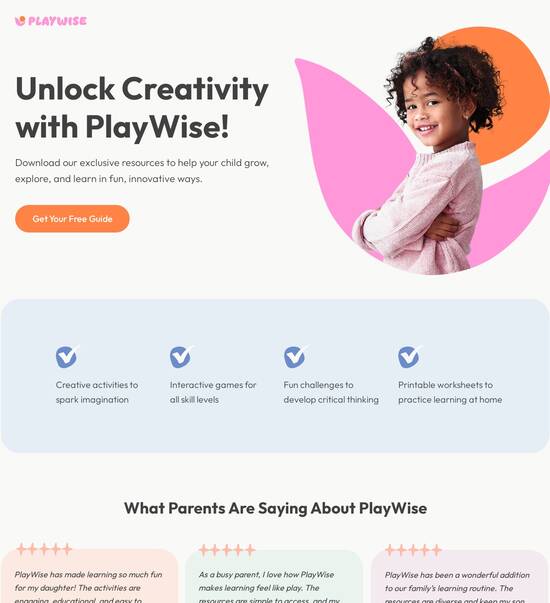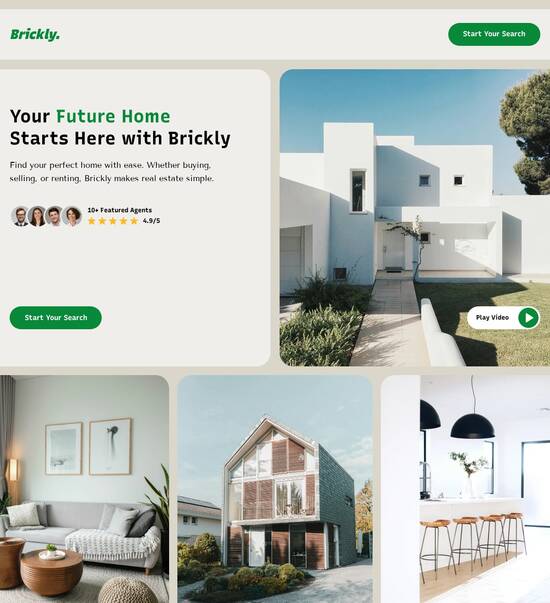
Dynamic user dashboard page template
Explore Similar TemplatesAbout template
Unleash your creativity with the dynamic user dashboard page template. Try Instapage today.
Recommended templates

Easy to build without coding
With the intuitive drag-and-drop builder, anyone on your team can create high-converting pages without any knowledge of code or design. Make enhancements to your landing page with custom widgets using Javascript, HTML/CSS, or third-party scripts.

Multiple layouts for any industry and goal
Select from 500+ landing page layouts built to boost conversions across industry-specific scenarios. Customize them by adjusting fonts, adding images, and generating on-brand content with the AI assistant. Quickly scale with Instablocks® and Global Blocks that you can save, reuse, and update globally.

Loads fast and looks polished on any device
Every template is responsive, which means they present professionally on any device and load blazingly fast with our Thor Render Engine. You can also power them up with Google AMP technology to deliver an unparalleled mobile experience and drive higher conversions.

Robust analytics & experimentation
Get real-time updates and reporting across all your devices, showing the number of visitors, conversions, cost-per-visitor, and cost-per-lead. Launch AI-powered experiments, run A/B tests, and use heatmaps to analyze user behavior, then optimize your landing page to maximize conversions.







Easy to build without coding
With the intuitive drag-and-drop builder, anyone on your team can create high-converting pages without any knowledge of code or design. Make enhancements to your landing page with custom widgets using Javascript, HTML/CSS, or third-party scripts.
Multiple layouts for any industry and goal
Select from 500+ landing page layouts built to boost conversions across industry-specific scenarios. Customize them by adjusting fonts, adding images, and generating on-brand content with the AI assistant. Quickly scale with Instablocks® and Global Blocks that you can save, reuse, and update globally.
Loads fast and looks polished on any device
Every template is responsive, which means they present professionally on any device and load blazingly fast with our Thor Render Engine.
Robust analytics & experimentation
Get real-time updates and reporting across all your devices, showing the number of visitors, conversions, cost-per-visitor, and cost-per-lead. Launch AI-powered experiments, run A/B tests, and use heatmaps to analyze user behavior, then optimize your landing page to maximize conversions.
All the features you need to build simple dashboard html template w3schools
Explore more featuresLearn how to build top-performing landing pages for any goal
FAQs
Leading the way in building high-performing landing pages





Maximize your marketing with Instapage's powerful landing page and CRO platform
Landing pages are critical to the success of digital marketing campaigns. Leveraging Instapage's landing page and conversion rate optimization (CRO) capabilities can significantly enhance your ability to drive leads, conversions, and overall return on investment (ROI). This guide provides a step-by-step approach to using Instapage effectively, particularly for businesses in marketing and advertising, tech, education, and financial services.
Step 1: Choosing the right template for your campaign
Instapage offers over 100 high-converting templates tailored to various industries. Selecting the right template is crucial as it influences user experience and conversion rates.
- Assess your goals: Define whether you aim for lead generation, product sales, or information dissemination.
- Consider your audience: Choose a template that resonates with the target audience in your specific industry such as business services or education.
- Evaluate design compatibility: Ensure that the template matches your brand's style and messaging to create a seamless user experience.
Step 2: Crafting compelling content
Once you’ve selected your template, focus on creating high-performing content that delivers value and drives action.
- Use dynamic text replacement: This feature personalizes experience by aligning your ad’s messaging with the landing page, enhancing relevance.
- Incorporate calls to action (CTAs): Strategically place clear and compelling CTAs that guide users on the next steps, crucial for conversions.
- Leverage user testimonials: Including social proof can build trust and credibility, encouraging visitors to engage with your offerings.
Step 3: Optimize for conversions
Optimization is essential for improving performance and understanding user behavior on your landing pages.
- Conduct A/B testing: Regularly test different elements such as headlines, images, and CTAs to identify the most effective versions.
- Utilize heatmaps: Use built-in heatmap features to visualize user interactions, allowing you to refine layout and content placements.
- Monitor analytics: Leverage performance metrics provided by Instapage's analytics dashboard to gauge effectiveness and adjust strategies accordingly.
By strategically employing these steps, businesses can create effective landing pages that cater to their specific audiences, enhancing the potential for conversions and improving marketing outcomes.
Ready to transform your landing pages and boost your marketing ROI? Start utilizing Instapage today to unlock success in your campaigns.
People also ask about Dynamic user dashboard page template
Understanding the dynamic user dashboard: A game changer for web design
The essence of a dynamic user dashboard
A dynamic user dashboard is an interactive interface that consolidates relevant information for users, enhancing their ability to interact with data in real-time. This concept has gained immense significance in web design, primarily due to the increasing demand for user-centric experiences. Users expect personalized content that aligns with their unique requirements and preferences, and a well-designed dashboard can deliver just that.
The evolution of dashboard templates has been noteworthy. Initially, dashboards presented static layouts with limited user interaction. However, as technology advanced, so did the expectations of users. Static designs have transitioned into dynamic experiences, characterized by customizable elements, real-time data processing, and responsive layouts that adapt seamlessly to various devices.
Key features of a dynamic dashboard template
Dynamic dashboards come with an array of features that enhance user experience and engagement. These features cater to the needs of various industries, enabling marketers and business professionals to efficiently manage their data.
Customizable Interface: A vital aspect of these dashboards is the ability for users to personalize their experience. This may include elevating brand consistency through adjustments in font-family and aligning color schemes with brand identity.
Responsive Design Elements: Modern web applications prioritize responsive templates, allowing for adaptable layouts that ensure accessibility across diverse devices, enhancing user engagement.
Interactive Widgets and Components: Essential widgets like charts and graphs enhance user understanding of data. Interactive components lead to increased engagement, encouraging users to explore insights.
Data Visualization Techniques: Information presentation is crucial. Utilizing various font sizes (font-size) and weights (font-weight) can improve readability, assisting users in retaining key messages.
User-Centric Navigation: Effective navigation design employs logical groupings and hierarchies, simplifying the user experience. Strategic navigation planning improves interaction and accessibility to important data.
Design aesthetics that influence user behavior
The design aesthetic of a dashboard plays a pivotal role in influencing user behavior and interactions. Key elements, such as typography, color psychology, and optimal space utilization, all contribute significantly to user engagement and satisfaction.
Typography Composition: Choices in font-family can drastically impact how users perceive a brand. Additionally, considerations like line-height and margin-top/bottom can significantly affect text readability.
Color Psychology in Dashboard Design: The choice of colors can evoke various emotional responses. Thoughtful color therapy in web design can lead to improved user interactions and drive actions.
Optimal Use of Space: Balancing white space with content is essential. Adequate margins (margin-top and margin-bottom) improve clarity, allowing users to focus on specific elements without feeling overwhelmed.
The benefits of implementing a dynamic dashboard template
Implementing a dynamic dashboard template brings a multitude of advantages that can substantially impact user engagement, workflow efficiency, and data analysis capabilities. These benefits are crucial for businesses seeking to optimize their operations.
Enhanced User Engagement: Interactive elements foster a deeper connection with users. Businesses utilizing dynamic dashboards often witness improved engagement metrics as users navigate through rich, interactive content.
Streamlined Workflows: A dynamic dashboard simplifies complex data and tasks, allowing users to swiftly identify key insights. For example, organizations that have adopted interactive dashboards experience heightened productivity levels.
Data-Driven Decision Making: Access to real-time analytics via dashboards empowers businesses to make informed strategic decisions, leveraging data insights for better forecasting and planning.
The future of dashboard design
Looking ahead, the future of dashboard design is set to be influenced by emerging trends such as artificial intelligence and machine learning. These technologies promise to personalize user experiences further, transforming how organizations interpret and interact with data.
Predictions indicate that the next generation of user dashboard templates will harness the power of advanced computing to not only present data but also analyze it. This evolution will continue to shift the landscape of dashboard design, making it an even more integral tool for businesses.
Implementing and customizing the template
Setting up a dynamic dashboard template may seem daunting initially. However, a step-by-step approach can simplify the process, ensuring a smooth transition.
Choosing the right platform for dashboard creation is critical. When selecting a platform, consider factors such as ease of use, flexibility, and the available templates.
Monitoring key metrics is essential for iterative improvement. Tracking user interactions and feedback can inform future updates to the dashboard.
Customizing existing templates to mirror unique brand aspects is key to standing out. Consider personalizing fonts, colors, and layouts to create a tailored experience.
Case studies: Transformations through dynamic dashboards
Successful transformations through dynamic dashboards are evident across various organizations. Understanding these case studies offers valuable insights into how effective dashboard integration can lead to significant improvements.
Organizations reflecting a successful implementation often report quantifiable impacts on user experience and operational efficiency. These success stories serve as blueprints for others looking to leverage the power of dashboard customization.
Conclusion imagined: The road ahead
As we move forward, it's crucial for organizations to adopt a mindset shift towards embracing dynamic templates. The impact of customizing dashboards extends beyond traditional limits, yielding richer user experiences.
Marketers and businesses are invited to consider the potential of these advanced tools to enhance brand trust and customer loyalty while boosting conversion rates. The journey to effective dashboard solutions is just beginning.
Ready to skyrocket conversions?
Supercharge your ad campaigns with high-performing landing pages
Get started














